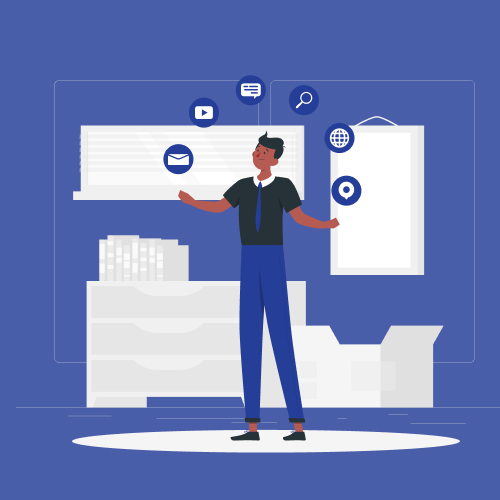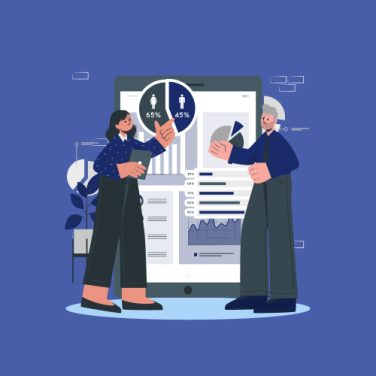Employee Self-Service (ESS) software is a digital portal where employees independently manage attendance, leave requests, payslips, and personal data.
As organisations move from manual paperwork to automated systems, these platforms have evolved from basic desktop tools to cloud-based, mobile-first solutions.
- Definition: A centralised portal for employees to manage attendance, leave balances, payslips, and personal information without HR intervention.
- Evolution: Transitioned from paper-based forms and on-premises solutions to cloud-hosted, mobile-first platforms accessible 24/7.
- Importance: Shifts routine processes from HR teams to employees, promoting autonomy, faster updates, and fewer data entry errors.
- Market context: Rising demand amid hybrid work, digital transformation, and the need for integrated employee portal software.
When combined with digital onboarding best practices, Employee Self-Service software ensures new hires and existing staff alike experience seamless HR interactions.
Adoption of self-service tools aligns with broader digital transformation initiatives. Organisations deploying robust portals report up to 50% reduction in routine HR queries and gains in employee satisfaction.
Overview at a glance
This TLDR highlights how employee self-service software empowers employees, reduces HR workload, and integrates seamlessly with existing systems.
- 24/7 access to core HR functions for employees, from any device via a mobile-first interface.
- Key benefits: significant reduction in HR queries, faster approvals, and improved data accuracy.
- Essential features include attendance tracking, leave management, payslip access, workspace reservation, and workflow automation.
- Integration with HRIS, payroll, and other MiHCM modules ensures end-to-end data consistency.
- Built-in AI analytics and SmartAssist chatbot unlock predictive insights for proactive HR management.
Key benefits for employees and HR
- Empowerment: Employees can update personal information, check leave balances, and manage time entries independently, reducing reliance on HR and fostering ownership.
- Efficiency: Automated workflows route requests for approvals, freeing HR teams to focus on strategic initiatives such as talent development and culture building.
- Accuracy: Direct data entry by employees minimises manual transcription errors in timesheets and leave records, ensuring reliable workforce metrics.
- Speed: Instant digital approvals accelerate processes—leave requests, expense claims, and payroll inputs occur in minutes rather than days.
- Engagement: Transparent access to real-time data, payslips, and company news builds trust, satisfaction, and alignment with organisational goals.
By leveraging employee portal software as part of a comprehensive HR strategy, organisations not only reduce administrative backlogs but also elevate the overall employee experience.
Integration with self-service HR tools, including MiA for mobile access and SmartAssist for AI-driven guidance, further enhances workforce productivity and supports continuous engagement.
Essential features of a self-service portal
Effective Employee Self-Service software must offer a comprehensive set of capabilities that support autonomous HR interactions and streamline organisational workflows. Below are the essential features every portal should include:
- Attendance and time management: Clock in/out, geofencing, and shift adjustment tools accessible via a user-friendly mobile app. Real-time tracking ensures accurate pay and compliance.
- Leave management: Employees can view leave balances, apply for time off, and monitor approval status through intuitive workflows, reducing back-and-forth with HR.
- Payslip access: Secure retrieval and download of salary slips via the MiA portal, enabling on-demand access to compensation records.
- Workflow automation: Automated routing of HR requests and approval notifications accelerates processes and cuts manual follow-ups.
- Workspace reservation: Hybrid office teams can reserve desks or meeting rooms in advance, optimising space and scheduling onsite days.
- AI chatbot: SmartAssist leverages natural language processing to answer common HR queries instantly, reducing HR tickets by up to 50%.
These features translate into measurable benefits:
- Reduced HR inquiries by up to 50% through self-service request handling.
- Improved payroll accuracy with real-time attendance and leave data integration.
- Accelerated approval workflows, cutting turnaround from days to minutes.
- Enhanced hybrid work flexibility via workspace booking and shift adjustments.
- Greater employee satisfaction by providing transparent access to personal and company information.
MiHCM’s suite—spanning Lite, Enterprise, Data & AI, Analytics, and SmartAssist—provides prebuilt connectors and APIs for seamless integration across all modules.
This unified approach ensures that data flows seamlessly from self-service portals into core HRIS and payroll systems, supporting strategic decision-making and continuous process improvement.
Mobile self-service: Empowering workforces anywhere
Mobile self-service software transforms smartphones and tablets into powerful HR portals.
Employees gain 24/7 access to core functions—attendance tracking, leave requests, payslip viewing, and workspace booking—directly from a mobile-friendly interface. This flexibility keeps operations running smoothly for distributed teams.
- 24/7 access: Manage time entries, approvals, and personal information on any internet-enabled device.
- Push notifications: Receive instant alerts for pending requests, policy changes, or upcoming deadlines.
- Use cases: Supports remote workers, field technicians, and shift-based staff who need real-time HR interactions.
Security considerations
Advanced authentication options—including fingerprint recognition and facial login—ensure secure access.
Industry-standard encryption protects data in transit and at rest, while role-based controls limit access to sensitive information. Built-in compliance features help meet GDPR and other privacy regulations.
Regular security audits and automatic updates keep the mobile platform resilient against emerging threats and ensure compliance with evolving regulatory requirements.
Integration with HR and Payroll systems
Seamless integration between employee self-service software and broader HRIS or payroll systems is critical for maintaining data consistency and reducing manual workload.
MiHCM’s platform offers prebuilt connectors and robust APIs, enabling automated data exchange and end-to-end process efficiency.
Improving HR efficiency and reducing workload
Employee Self-Service software transforms HR operations by automating routine tasks and providing comprehensive visibility.
- Task automation: Auto-routes requests and sends reminders for approvals, minimising manual follow-ups and missed deadlines.
- Centralised dashboard: Presents an overview of leave requests, time entries, and workspace bookings, reducing the need for multiple spreadsheets.
- Analytics: Identifies bottlenecks, tracks service levels, and optimises workflows using visual reports from the Analytics module.
- Self-help resources: Integrated knowledge bases and FAQ chatbots deflect repetitive inquiries, freeing HR to focus on strategic initiatives.
In addition, self-service HR tools improve compliance by logging all user actions and approvals. Automated audit trails provide irrefutable records during internal and external reviews, reducing legal and financial risks. This shift enables HR to deliver higher-value services such as workforce planning and employee development programmes.
Employee engagement and culture building
Employee Self-Service portals play a pivotal role in fostering a positive workplace culture and enhancing engagement.
- Peer recognition: Celebrate milestones like work anniversaries and birthdays directly in the portal, driving morale and camaraderie.
- Company news: Broadcast announcements, policy updates, and event invitations through targeted notifications or news feeds.
- Pulse surveys: Launch quick employee sentiment surveys to gather feedback on initiatives, work environment, and leadership.
- Community features: Discussion forums and social walls facilitate knowledge sharing, team collaboration, and cross-functional networking.
Integrating these engagement tools within the same platform that employees use for daily HR tasks ensures consistent usage and better adoption rates. Content analytics track participation rates and sentiment trends, providing HR leaders with actionable insights to refine culture programs.
Compliance and data security
Ensuring compliance and safeguarding sensitive employee data are top priorities for any HR platform. Employee self-service software must include robust security and regulatory features to protect information and reduce legal risks.
- Role-based access: Configurable permissions guarantee that only authorised users can view or edit specific data fields, minimising insider threats.
- Audit trails: Comprehensive logs record every action—form submissions, approvals, and data changes—facilitating internal audits and external compliance reviews.
- Encryption: Data is encrypted both at rest and in transit using industry-standard protocols, protecting against unauthorised interception or breaches.
- Regulatory compliance: Built-in support for global and local labour law requirements ensures organisations meet relevant obligations.
- Automated reminders: Configurable alerts notify employees and HR teams about upcoming training deadlines, policy acknowledgments, and document renewals.
MiHCM’s platform offers continuous monitoring and regular security updates, maintaining resilience against emerging threats. Integrated compliance dashboards provide a high-level overview of status across regions, simplifying governance for multinational organisations.
Regular penetration testing and third-party audits are supported, giving leadership confidence in the integrity of HR systems. Transparent reporting tools ensure that audit findings can be addressed promptly and comprehensively.
AI and Analytics in self-service HR
Embedding AI and analytics capabilities within employee self-service software unlocks powerful insights and enables proactive HR management.
- Predictive insights: Forecast absenteeism trends and turnover risk by analysing historical attendance and engagement metrics.
- Dashboard visualisations: Interactive charts display attendance patterns, leave clusters, and workforce capacity in real time.
- SmartAssist chatbot: Uses natural language processing to answer FAQs, guide users through workflows, and escalate complex cases to HR professionals.
- Data-driven decisions: Leverage analytics outputs to optimise hiring plans, staffing levels, and shift schedules based on demand forecasts.
- Trend analysis: Monitor productivity, well-being indicators, and training completion rates to identify areas for intervention.
By harnessing AI-driven recommendations and real-time analytics, organisations can shift HR from reactive to proactive, improving employee retention, satisfaction, and operational efficiency across the workforce.
Frequently asked questions
What are the benefits of Employee Self-Service software?
How does self-service software improve HR efficiency?
What features should be included in an Employee Self-Service portal?
Core features include attendance and time management with geofencing, leave management, secure payslip downloads, a mobile app with offline access, workflow automation, workspace reservation, AI-powered chatbot for instant support, peer recognition tools, and real-time policy updates.



